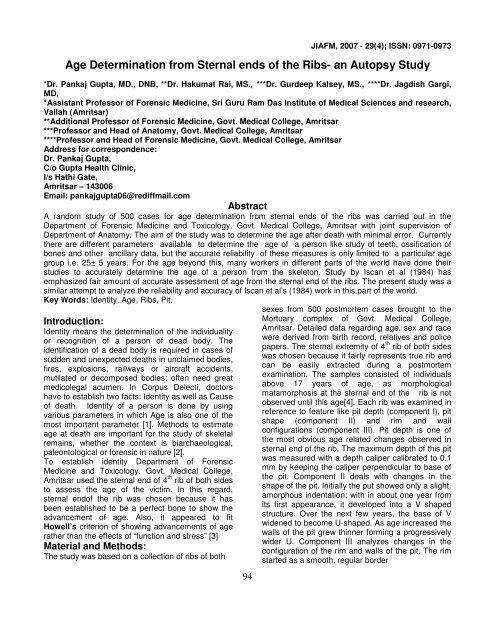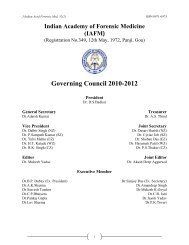Download - forensic medicine
Download - forensic medicine
Download - forensic medicine
You also want an ePaper? Increase the reach of your titles
YUMPU automatically turns print PDFs into web optimized ePapers that Google loves.
94<br />
JIAFM, 2007 - 29(4); ISSN: 0971-0973<br />
Age Determination from Sternal ends of the Ribs- an Autopsy Study<br />
*Dr. Pankaj Gupta, MD., DNB, **Dr. Hakumat Rai, MS., ***Dr. Gurdeep Kalsey, MS., ****Dr. Jagdish Gargi,<br />
MD,<br />
*Assistant Professor of Forensic Medicine, Sri Guru Ram Das Institute of Medical Sciences and research,<br />
Vallah (Amritsar)<br />
**Additional Professor of Forensic Medicine, Govt. Medical College, Amritsar<br />
***Professor and Head of Anatomy, Govt. Medical College, Amritsar<br />
****Professor and Head of Forensic Medicine, Govt. Medical College, Amritsar<br />
Address for correspondence:<br />
Dr. Pankaj Gupta,<br />
C/o Gupta Health Clinic,<br />
I/s Hathi Gate,<br />
Amritsar – 143006<br />
Email: pankajgupta06@rediffmail.com<br />
Abstract<br />
A random study of 500 cases for age determination from sternal ends of the ribs was carried out in the<br />
Department of Forensic Medicine and Toxicology, Govt. Medical College, Amritsar with joint supervision of<br />
Department of Anatomy. The aim of the study was to determine the age after death with minimal error. Currently<br />
there are different parameters available to determine the age of a person like study of teeth, ossification of<br />
bones and other ancillary data, but the accurate reliability of these measures is only limited to a particular age<br />
group i.e. 25± 5 years. For the age beyond this, many workers in different parts of the world have done their<br />
studies to accurately determine the age of a person from the skeleton. Study by Iscan et al (1984) has<br />
emphasized fair amount of accurate assessment of age from the sternal end of the ribs. The present study was a<br />
similar attempt to analyze the reliability and accuracy of Iscan et al’s (1984) work in this part of the world.<br />
Key Words: Identity, Age, Ribs, Pit.<br />
Introduction:<br />
Identity means the determination of the individuality<br />
or recognition of a person of dead body. The<br />
identification of a dead body is required in cases of<br />
sudden and unexpected deaths in unclaimed bodies,<br />
fires, explosions, railways or aircraft accidents,<br />
mutilated or decomposed bodies; often need great<br />
medicolegal acumen. In Corpus Delecti, doctors<br />
have to establish two facts: Identity as well as Cause<br />
of death.<br />
Identity of a person is done by using<br />
various parameters in which Age is also one of the<br />
most important parameter [1]. Methods to estimate<br />
age at death are important for the study of skeletal<br />
remains, whether the context is biarchaeological,<br />
paleontological or <strong>forensic</strong> in nature [2].<br />
To establish identity Department of Forensic<br />
Medicine and Toxicology, Govt. Medical College,<br />
Amritsar used the sternal end of 4 th rib of both sides<br />
to assess the age of the victim. In this regard,<br />
sternal endof the rib was chosen because it has<br />
been established to be a perfect bone to show the<br />
advancement of age. Also, it appeared to fit<br />
Howell’s criterion of showing advancements of age<br />
rather than the effects of “function and stress” [3]<br />
Material and Methods:<br />
The study was based on a collection of ribs of both<br />
sexes from 500 postmortem cases brought to the<br />
Mortuary complex of Govt. Medical College,<br />
Amritsar. Detailed data regarding age, sex and race<br />
were derived from birth record, relatives and police<br />
papers. The sternal extremity of 4 th rib of both sides<br />
was chosen because it fairly represents true rib and<br />
can be easily extracted during a postmortem<br />
examination. The samples consisted of individuals<br />
above 17 years of age, as morphological<br />
matamorphosis at the sternal end of the rib is not<br />
observed until this age[4]. Each rib was examined in<br />
reference to feature like pit depth (component I), pit<br />
shape (component II) and rim and wall<br />
configurations (component III). Pit depth is one of<br />
the most obvious age related changes observed in<br />
sternal end of the rib. The maximum depth of this pit<br />
was measured with a depth caliper calibrated to 0.1<br />
mm by keeping the caliper perpendicular to base of<br />
the pit. Component II deals with changes in the<br />
shape of the pit. Initially the put showed only a slight,<br />
amorphous indentation; with in about one year from<br />
its first appearance, it developed into a V shaped<br />
structure. Over the next few years, the base of V<br />
widened to become U-shaped. As age increased the<br />
walls of the pit grew thinner forming a progressively<br />
wider U. Component III analyzes changes in the<br />
configuration of the rim and walls of the pit. The rim<br />
started as a smooth, regular border




![syllabus in forensic medicine for m.b.b.s. students in india [pdf]](https://img.yumpu.com/48405011/1/190x245/syllabus-in-forensic-medicine-for-mbbs-students-in-india-pdf.jpg?quality=85)



![SPOTTING IN FORENSIC MEDICINE [pdf]](https://img.yumpu.com/45856557/1/190x245/spotting-in-forensic-medicine-pdf.jpg?quality=85)

![JAFM-33-2, April-June, 2011 [PDF] - forensic medicine](https://img.yumpu.com/43461356/1/190x245/jafm-33-2-april-june-2011-pdf-forensic-medicine.jpg?quality=85)



![JIAFM-33-4, October-December, 2011 [PDF] - forensic medicine](https://img.yumpu.com/31013278/1/190x245/jiafm-33-4-october-december-2011-pdf-forensic-medicine.jpg?quality=85)

